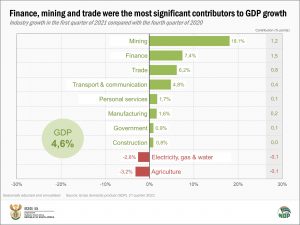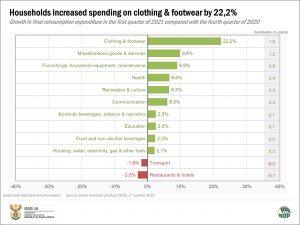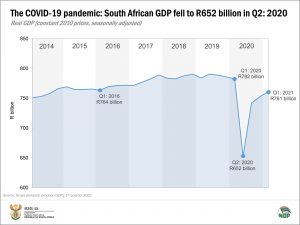GDP rises in the first quarter of 2021
The South African economy grew by 1,1% in the first quarter of 2021 (January–March), translating into an annualised growth rate of 4,6%.1 This follows a revised 1,4% (annualised: 5,8%) rise in real gross domestic product (GDP) in the fourth quarter of 2020.
The finance, mining and trade industries were the main drivers of output on the production (supply) side of the economy, while household spending and changes in inventories helped spur growth on the expenditure (demand) side.
Despite this being the third consecutive quarter of positive growth, the South African economy is 2,7% smaller than it was in the first quarter of 2020.
Finance, mining and trade drive production
Eight of the ten industries recorded positive gains in the first quarter of 2021, with finance, mining and trade making the most significant contributions.
Economic activity in the finance, real estate & business services industry increased at an annualised rate of 7,4%. This was mostly driven by property services (recording a rise in mortgage advances and bond registrations) and the banking sector (registering a rise in the number of credit extensions).
The mining industry had a positive quarter too with annualised growth of 18,1%, boosted by the production of platinum group metals, iron ore, gold and chromium. On the downside, miners in manganese ore, coal and diamonds recorded lower production figures in the first quarter.
Strong wholesale and retail activity underpinned growth in the trade industry. Wholesalers recorded increases in sales of petroleum, as well as in consumer electronics (most notably digital appliances and high-end TVs). Retailers enjoyed a positive quarter, led by increases in sales of grocery products, healthcare services, vitamins and drugs.
Manufacturing output increased at an annualised rate of 1,6%, mostly driven by strong growth in the production of motor vehicles, parts and accessories and other transport equipment. Manufactures in wood, paper and printing made a notable contribution too, supported by strong demand for packing materials and increased newspaper sales.
Load shedding and a decline in the supply of water contributed to the contraction in the electricity, gas & water supply industry. The agriculture, forestry & fishing industry also performed poorly in the first quarter in comparison with the previous quarter, dragged lower by weaker production figures for field crops and animal products.
Households spend more on insurance, retail, clothing and furniture
Stats SA also measures the expenditure side of GDP, providing an indication of total demand in the economy. This includes measures of household spending, government spending, investment spending (gross fixed capital formation and changes in inventories), and net exports.
Household final consumption expenditure increased at an annualised rate of 4,7% in the first quarter, driven largely by miscellaneous goods & services, clothing & footwear, and furnishings, household equipment & maintenance.
Notable items in the ‘miscellaneous goods & services’ category that recorded growth include insurance-related products, as well as retail goods such as electrical appliances, jewellery and other personal effects.
Clothing & footwear expenditure increased at an annualised rate of 22,2%.
Changes in inventories, particularly in the mining and trade industries, also spurred growth on the expenditure side of the economy.
How far to go before we return to pre-COVID levels?
The COVID-19 pandemic and subsequent lockdown restrictions caused significant disruptions to the South African economy. Real GDP was R782 billion in the first quarter of 2020 (January–March).2 In the second quarter of 2020 (April–June), when lockdown restrictions were at their most stringent, economic output slumped to R652 billion (click on the chart to enlarge).
Economic activity has increased since then, in line with easing lockdown restrictions, with real GDP rising to R761 billion in the first quarter of 2021. This level is roughly comparable to what the economy was producing in the first quarter of 2016, and is 2,7% down from the R782 billion recorded in the first quarter of 2020.
For more information, download the GDP release and media presentation for the first quarter of 2021 here.
1 Quarter-on-quarter change in GDP (measured by production), in real (volume) terms, seasonally adjusted.
2 GDP (measured by production), constant 2010 prices, seasonally adjusted, not annualised.
Similar articles are available on the Stats SA website and can be accessed here.
For a monthly overview of economic indicators and infographics, catch the latest edition of the Stats Biz newsletter here.




